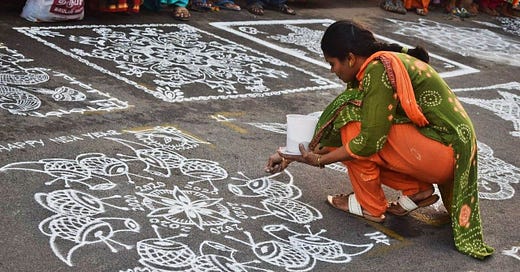Welcome to the Brown History Newsletter. If you’re enjoying this labour of love, please do consider becoming a paid subscriber. Your contribution would help pay the writers and illustrators and support this weekly publication. If you like to submit a writing piece, please send me a pitch by email at brownhistory1947@gmail.com. Check out our Shop and our Podcast. You can also follow us on Instagram and Twitter.
Tracing the Significance of Kolams by Neeraja Srinivasan
I cannot recall when I first noticed the kolams of Madras. Of course, I always knew that they were an important aspect of South-Indian aesthetic tradition, but when did I really start noticing the kind of intricacies, effort and preparation that surrounded the making of a kolam? It could’ve been during a heritage walk in Mylapore, an area in Madras synonymous with eclectic paradigms of architecture, historical enclaves and vibrant, indigenous houses with complex kolams decorating their entrances. It could’ve also been at home, as I observed my mother make tidy notes while she practiced kolam patterns in her notebook from YouTube tutorials. A kolam is many things; an elegant art form, a daily ritual, a mathematical sequence and a representation of the ‘ideal’ Tamil woman. Kolams are decorative geometrical patterns that adorn the entrances of households, places of worship; it is a line drawing of curves and loops around a regular grid of points. Historically, mentions of kolams can be found in Sangam literature, wherein women used kolams, as they continue to do today, to decorate thresholds. Research scholar Ramaa Narayanan has translated these images from ancient writings to mean ‘curious drawings’. Variations of these so-called curious drawings exist all over India; rangolis from Gujarat, alpanas from West Bengal, jhotis from Orissa, mandanas from Rajasthan and muggus from Andhra Pradesh, to name a few!
What makes these patterns curious? Why is this expressive art form significant to Tamil culture? For me, it all started with a festival specific tradition; every year, during the harvest festival of Pongal, my neighbours and I would watch my mother go about cleansing the entrance of our apartment, pick up a specially prepared white kolam powder using her forefinger, and then layer it all across the ground to make a large design, that my friends and I would try to amateurally replicate on the floor of the second entrance to our flat. I realised quite earlier on, that this ritual involved rather high levels of concentration, calculation and a pinch of mathematical thinking. But more than anything, since kolams are only constrained by broad rules, these designs offer scope for detailing, creativity of the highest order and great amounts of patience, of course. Most designs chosen by women use foundations of a shape of pullis or dots to form squares, triangles or rectangles. Based on these simple shapes, lines are traced across the pullis to form symmetrical, geometric patterns of flowers, deities, fruits, instruments, animals, chariots, what not, depending on purpose, intention and symbolic value. Fascinating research has been conducted by a certain Dr. S. Narayanan, who demonstrated with theory and examples, the connection between the beauty of Tamil kolams with the elegance of the well known Fibonacci Numbers.





